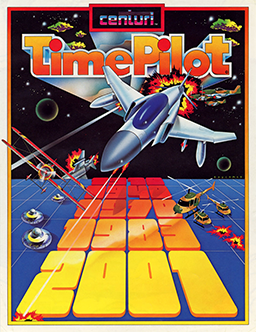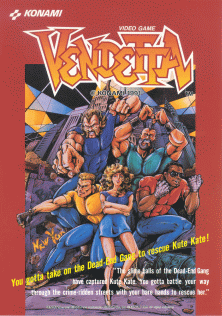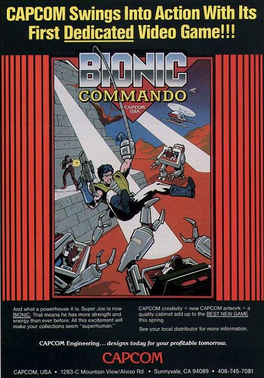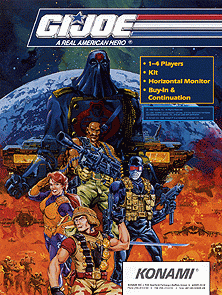
Contra is a 1987 run and gun video game developed and published by Konami for arcades. A home version was released for the Nintendo Entertainment System in 1988, along with ports for various home computer formats, including the MSX2. The arcade and computer versions were localized as Gryzor in Europe, and the NES version as Probotector in PAL regions and France.

Mach Rider is a vehicular combat racing video game developed by HAL Laboratory and published by Nintendo. It was first released for the Famicom console and Nintendo VS. System arcade board in Japan in 1985, then in North America for the VS. System in 1985 and Nintendo Entertainment System in 1986, and then for the PAL region in 1987. It was released on the Virtual Console for the Wii (2007), Nintendo 3DS (2013), Wii U (2014), and on the Nintendo Switch Online service (2024).

Time Pilot is a multidirectional shooter arcade video game designed by Yoshiki Okamoto and released by Konami in 1982. It was distributed in the United States by Centuri, and by Atari Ireland in Europe and the Middle East. While engaging in aerial combat, the player-controlled jet flies across open airspace that scrolls indefinitely in all directions. Each level is themed to a different time period. Home ports for the Atari 2600, MSX, and ColecoVision were released in 1983.

Salamander, retitled Life Force in North America and in the Japanese arcade re-release, is a scrolling shooter arcade video game developed and published by Konami. Released in 1986 as a spin-off of Gradius, Salamander introduced a simplified power-up system, two-player cooperative gameplay and both horizontally and vertically scrolling stages. Some of these later became normal for future Gradius games. In Japanese, the title is written using ateji, which are kanji used for spelling foreign words that has been supplanted in everyday use by katakana. Contra, another game by Konami was also given this treatment, with its title written in Japanese as 魂斗羅.

Vendetta, known in Japan as Crime Fighters 2 (クライムファイターズ2), is a 1991 side-scrolling beat-'em-up arcade game developed and published by Konami. It is the sequel to 1989 Konami's Crime Fighters, although it was marketed internationally as a stand-alone game with no previous connections.

Teenage Mutant Ninja Turtles: Turtles in Time, released as Teenage Mutant Hero Turtles: Turtles in Time in Europe, is a 1991 beat 'em up game developed and published by Konami for arcades. A sequel to the original Teenage Mutant Ninja Turtles arcade game, it is a side-scrolling game based mainly on the 1987 TMNT animated series. Originally an arcade game, Turtles in Time was ported to the Super Nintendo Entertainment System in 1992 under the title Teenage Mutant Ninja Turtles IV: Turtles in Time, continuing the numbering from the earlier Turtles games released on the original NES. That same year, a game that borrowed many elements, Teenage Mutant Ninja Turtles: The Hyperstone Heist, was released for the Sega Genesis.

Rush'n Attack, also known as Green Beret in Japan and Europe, is a run-and-gun and hack-and-slash video game developed and released by Konami for arcades in 1985, and later converted to the Nintendo Entertainment System and home computers. Its North American title is a play on the phrase "Russian attack" due to its Cold War setting. It was ported to home systems and became a critical and commercial success for arcades and home computers.

Jackal, also distributed under the title of Top Gunner, is an overhead run and gun video game released for arcades by Konami in 1986. The player must maneuver an armed jeep in order to rescue prisoners of war (POWs) trapped in enemy territory.
Gradius is a series of shooter video games, introduced in 1985, developed and published by Konami for a variety of portable, console and arcade platforms. In many games in the series, the player controls a ship known as the Vic Viper.

Dark Adventure is a dimetric action-adventure game produced by Konami that was released for the arcades in North America in 1987. It was the first arcade game by Konami that allowed up to three players simultaneously. The game was also released as Majū no Ōkoku in Japan and as Devil World in other countries outside North America, although these versions feature significant gameplay differences and only allow up to two players.

Parodius! From Myth to Laughter, released in Japan as Parodius Da! Shinwa kara Owarai e and outside Japan as Parodius, is a shoot 'em up arcade video game and the second title in the Parodius series produced by Konami. The European SNES, Sega Saturn and PlayStation versions are also known as Parodius: Non-Sense Fantasy. The gameplay is stylistically very similar to the Gradius series, but the graphics and music are intentionally absurd.

Salamander 2 is a 1996 horizontally scrolling shooter arcade video game developed and published in Japan by Konami. It is the direct sequel to Salamander (1986) and the third game in the Salamander series, which itself is a spin-off of the Gradius franchise. Up to two players control two starships — the Vic Viper and the Super Cobra — as they must destroy the alien race Doom before they wipe out all of the planet Gradius. Gameplay involves shooting down enemies, collecting power-up items, and avoiding collision with projectiles or obstacles.

Gradius V is a Japanese-developed shoot 'em up video game published by Konami for the Sony PlayStation 2 video game console in 2004. Gradius V was largely developed under contract by Treasure, who had previously worked on Radiant Silvergun and Ikaruga. The game is set predominantly in outer space where players control a fictional spacecraft called Vic Viper through a continuously scrolling background depicting the territories of Bacterian—an evil empire which serves as the player's enemy. Gradius V received overall positive reviews. Critics praised the level design, graphical design and "classic" revival, but criticized the game's difficulty.

Metal Hawk is a 1988 multidirectional shooter arcade video game developed and published by Namco. Assuming control of the titular attack helicopter, the player is tasked with using a machine gun and air-to-surface missiles to destroy enemies and earn a certain number of points before the timer runs out, all while avoiding collision with ether enemy projectiles and obstacles. The Metal Hawk can change its altitude to allow it to either rise higher in the air or lower towards the ground. It runs on the Namco System 2 arcade board.

B-Wings is a vertically scrolling shooter first released as an arcade video game by Data East in 1984. A version was released in 1986 for the Family Computer. It was Data East's first home release for the console. The Family Computer version is notable for its inclusion in many unofficial Famiclone multicarts.

Metamorphic Force is an arcade game released by Konami in August 1993. It is one of Konami's last side-scrolling beat 'em up games to appear in the arcades along with Violent Storm.

Konami GT, originally known as Konami RF2 - Red Fighter, is a 1985 racing video game developed and released by Konami, using their GX400 arcade architecture. The player drives a sports car which must reach various checkpoints without running out of fuel. A turbo mode increases the car's speed but uses more fuel and puts the player at a higher risk of hitting an obstacle. Fuel power-ups can be found on the road which the player must pick up to make it to the final checkpoint.

Bionic Commando, released in Japan as Top Secret is a run and gun platform game released by Capcom in arcades in 1987. It was designed by Tokuro Fujiwara as a successor to his earlier "wire action" platformer Roc'n Rope (1983), building on its grappling hook mechanic; he was also the designer of Commando (1985). The music was composed by Harumi Fujita for the Yamaha YM2151 sound chip.

G.I. Joe is a third-person rail shooter video game produced by Konami and released in 1992 for video arcades. It is based on the cartoon series G.I. Joe: A Real American Hero and stars four characters from the show: Duke, Snake Eyes, Scarlett, and Roadblock.

The Final Round, released in Japan as Hard Puncher, is a boxing arcade game released by Konami in 1988.

















